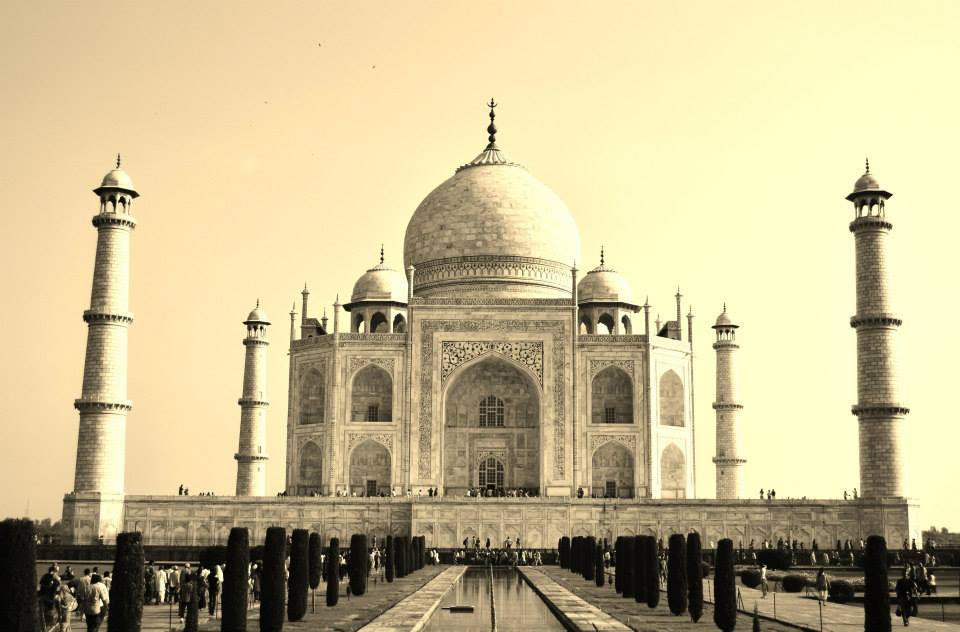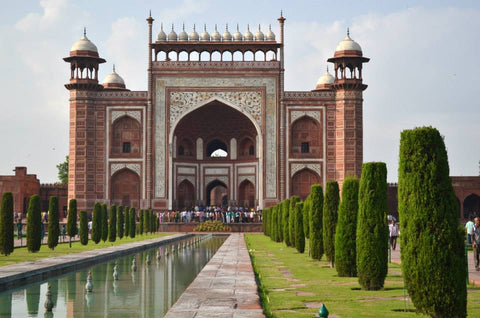The Taj Mahal - An Indian Love Story This Valentine’s Day
By Conchita de Souza

As synonymous with India as it is with love - the majestic Taj Mahal is in fact a sepulchre built from an emperor’s utter love and devotion to his wife and mother of his children. Whilst most of you would be familiar with the sight, you may not have come across the story behind the Taj Mahal - of Emperor Shah Jahan and his wife Mumtaz. As it just so happens to be Valentine’s Day, I would like to unravel it for you, along with the story of my first encounter with this timeless mausoleum (which happens to be one of the seven wonders of the world).
Whenever my family visited India, our trip was always divided between Goa and Bombay, located on India’s west coast. These places were where our relatives lived and holidays in India meant creating as many memories as we could with them to make up for our semi-permanent absence in their lives.
Despite having travelled many times to India throughout my childhood, my first visit to the Taj was soon after I had turned twenty-four. I had joined a year-long fellowship program* and was placed with an organisation in Noida, a suburb just outside of India’a capital - Delhi. At random, a few of my co-fellows and I planned a trip to Agra, the host city of the Taj Mahal, and located around 3.5 hours drive from Delhi. We hopped on board a rickety government bus all the way to Agra and arrived in the bustling and crowded part of the old city. The monsoons had by now reduced to trickles and the air was filled with a lingering humidity that intensified as the morning wore off.
My co-fellows and I met with a fellow named Ram from the previous batch who was local to the city. He would be our guide for the day and we ended up staying at the hotel run by his father the very same night. We quickly scoffed down some street food (I can’t remember what it was, but I do remember that it was spicy) and lined up to get our entry tickets. A large wall surrounds the compounds of the Taj Mahal, and though I could see her white peaks, I couldn’t see anything else until our queue finally snaked into the entrance gateway. And such an exquisite entrance could only be the prelude to something far more magical.

Entrance to the Taj Mahal
And there she was standing tall and majestic, in all her glory and splendour. White as pearl and full of radiance. One almost felt inclined to bow down in her presence. The design of the Taj was influenced by Mughal, Hindu and Persian architecture and the three styles are beautifully intertwined. The attention is in the detail they say, and this couldn’t be more applicable when writing of the Taj. Materials came from as far as China and Afghanistan and included different variations in marble and twenty-eight different precious and semi-precious stones. What amazed me even more whilst exploring its interiors, was the intricate floral designs carved out from the marble, appearing as effortless as someone drawing with pencil on paper. To the left of the Taj is a mosque and to the right is a guesthouse, both of which are identical in outer appearance.
After exploring the buildings and battling the constant stream of tourists (most of whom were locals), my co-fellows and I sat down in a shaded area on the cooling marble floors, unable to comprehend just how beautiful and magnificent a structure can be manifested out of romantic love.
Emperor Shah Jahffan was a Mughal** ruler and had one of the wealthiest empires of the time. He met and fell in love with Arjumand Banu (whom he renamed Mumtaz, meaning ‘Jewel of the Palace’), an intelligent, caring and beautiful princess from Persia and was betrothed to her when they were both teenagers. It has been well-documented that although Jahan had two wives before he married Mumtaz, she was always the love of his life and he shared a profound connection with her. She was always by his side and influenced his political and military strategies. The people loved Mumtaz, for she was considerate towards others. She also gave him a mere fourteen children, seven of whom died in their infancy. The year was 1631 and it was during the birth of Mumtaz’s fourteenth child that she experienced severe haemorrhaging and died to the pain-stricken grief of her husband and children.

A painting of the lovers. Artist unknown.
Shah Jahan was a patron of the arts, especially architecture. He was also responsible for building Jama Masjid and Red Fort, both located in Old Delhi. He wanted his beloved’s earthly resting place to be as close to paradise as possible, and set about working with architects to recreate heaven on earth. He consumed himself with this project as a distraction from the grief and emptiness. Work on the Taj Mahal began, and it would take 20 years (surprisingly expedient considering the fact that there was no mechanical equipment at the time), 1,000 elephants and nearly 22,000 labourers, artisans, craftsmen, calligraphers and masons to complete the project.
Soon after completion of the Taj Mahal, Shah Jahan fell ill and was deposed by his son Aurangzeb. By this time, Shah Jahan had become unpopular because of his ridiculous expenditure on building the Taj and other grand structures at the expense of his kingdom’s basic needs. He entered into unsuccessful battles for land, which also put a strain on the economy. His sons fought amongst each other for the throne and Aurangzeb was victorious and deposed his father and imprisoned him in Agra fort located on the other side of the Jumuna River and from which Shah Jahan could view the Taj Mahal. Shah Jahan died eight years later, in 1666 and was buried next to his beloved in the Taj.
I was sad to leave the Taj Mahal that day and if time permitted, I could have sat there for hours more, merely gazing in awe at its appearance. The story of Shah Jahan and Mumtaz spurred ruminations - was it love or selfishness that gave rise to the Taj Mahal? Did Shah Jahan want the Taj to be an ode to his love for Mumtaz or a symbol of his reign and prowess forever etched in history? Were he and Mumtaz reunited in paradise? Will I ever find someone who loves me enough to build such a grand structure in my honour? I put my questions to rest and left the Taj Mahal to explore the other delights Agra had to offer.

*A fellowship is like an internship, but more focused on professional development and is usually undertaken in more of a communal setting.
** Rulers of Islamic faith
